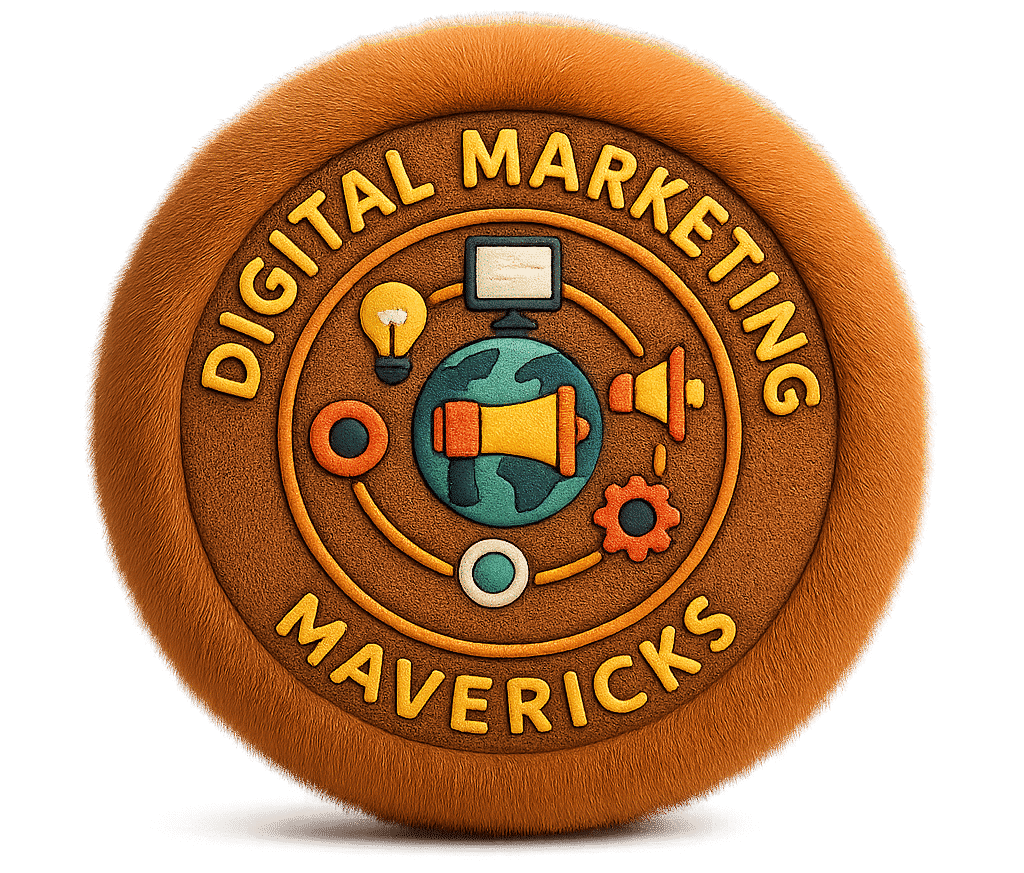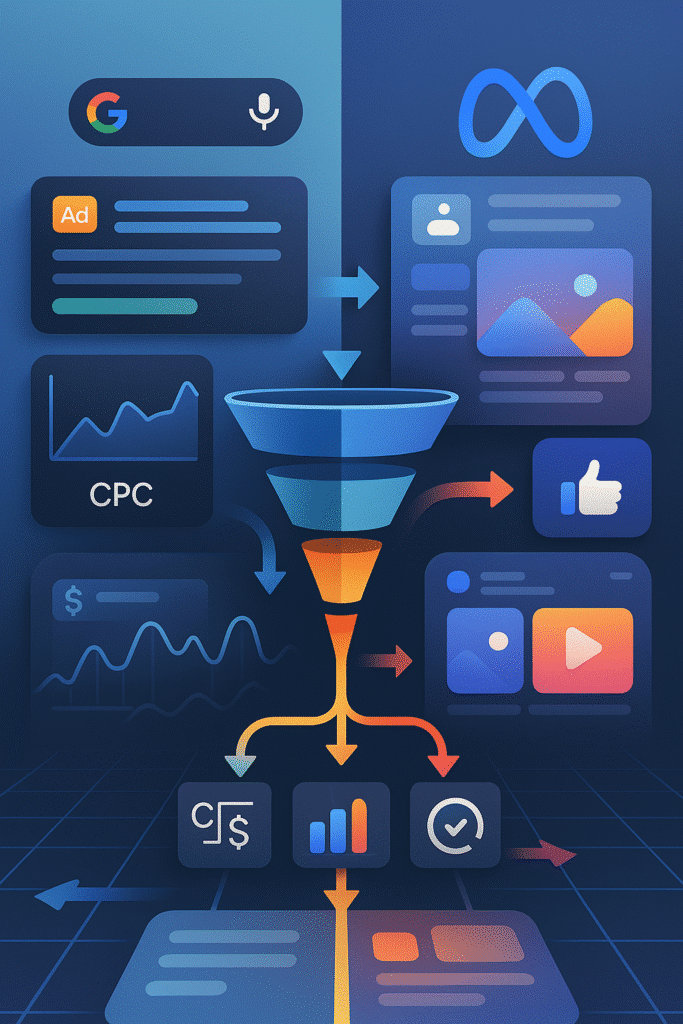Let’s be honest, running paid ads is easy.
Anyone can open Google Ads or Meta Ads Manager, hit “boost post” or “create campaign,” and start spending money.
But running profitable, scalable campaigns that actually drive leads and sales?
That takes strategy.
And that’s exactly what most businesses skip.
They jump into paid advertising without clear goals, without understanding their audience, and without a plan to convert clicks into revenue. The result?
High ad spend. Low returns. And a feeling that “PPC just doesn’t work.”
Here’s the truth:
PPC works when it’s done with intention.
This guide will walk you through the foundations of a smart, sustainable PPC strategy for both Google Ads and Meta Ads.
We’re not just talking campaign setup, we’re covering the full journey:
- From goal setting and funnel mapping
- To audience building and ad creative
- To budgeting, optimization, and performance tracking
Whether you’re running search ads, display, YouTube, Instagram Reels, or Facebook retargeting, the core principles of paid strategy don’t change.
But how you apply them to each platform? That’s what separates average from elite.
Let’s build a paid ads strategy that makes every click count.
What Is a PPC Strategy ?
A PPC strategy is a structured plan that guides every decision you make in your paid advertising campaigns from which platforms to use, to who you target, to how you structure your offers and measure success.
It’s not the tactics (like which headline to test or what image to use).
It’s the blueprint.
Your strategy should answer:
- What are we trying to achieve?
- Who are we trying to reach?
- Where do they hang out (Google vs Meta)?
- What message will move them to take action?
- What happens after they click?
Without a strong ppc strategy, most campaigns end up in what we call “ad limbo” — running endlessly with no clear goal, weak targeting, and even weaker ROI.
PPC Strategy ≠ Campaign Setup
Setting up a campaign is not the same as having a strategy.
- A campaign setup is what you do in the ads manager
- A strategy is what happens before that and what guides everything that comes after
If campaign setup is building the car, ppc strategy is deciding where you’re going, why you’re going there, and which roads you’ll take.
What Happens Without a Strategy?
Here’s what we see all the time:
- Ads targeting the wrong audience
- Conflicting messages across platforms
- Budgets wasted on cold traffic with no follow-up
- Zero conversion tracking
- Clients asking, “So… is this working?”
Strategy is what aligns your business goals with your paid campaigns so every dollar spent has a purpose. Here are 7 easy steps to come up with your own ppc strategy!

Step 1: Clarify Your Goals
Before you write a single headline or pick a daily budget, you need to answer this:
What are you trying to achieve with your PPC campaign?
And no, “more visibility” isn’t enough.
You need specific, measurable business goals that match your stage, offer, and audience.
Common PPC Goals Include:
- Lead generation (form fills, phone calls, bookings)
- Ecommerce sales (conversions, ROAS targets)
- Website traffic (especially for retargeting later)
- Brand awareness (reach, impressions, video views)
- App installs or product signups
- Event registrations or offer claims
Your goal will directly shape:
- The campaign objective you choose
- The targeting and bidding model
- The creative and call to action
- How you track and report results
Google vs Meta: Goal Differences Matter
Both platforms offer powerful tools, but they serve different purposes.
| Goal | Google Ads | Meta Ads |
|---|---|---|
| Direct Intent (searching now) | Search & Shopping campaigns | Less ideal |
| Demand Creation (brand awareness, interest) | Display, YouTube | Strong for cold audiences |
| Retargeting & Nurturing | RLSAs, Display | Dynamic retargeting, Custom Audiences |
| Ecommerce | Smart Shopping / PMAX | Product catalog ads, Instagram & Tik Tok shops |
A strong PPC strategy often combines both platforms to cover the full funnel.
Pro Tip: Tie Your Goals to Business Outcomes
Not just clicks. Not just impressions.
We’re talking real metrics:
- Cost per lead
- Return on ad spend (ROAS)
- Customer acquisition cost (CAC)
- Conversion rate
- Value per conversion
Because the algorithm can’t optimize for goals you don’t define.
Step 2: Choose the Right Platforms (Google, Meta, or Both?)
Not all clicks are created equal, and not all platforms serve the same purpose.
One of the biggest PPC strategy mistakes?
Running the same offer, the same way, across Google and Meta.
Smart advertisers don’t treat platforms like competitors.
They treat them like tools in a toolkit, each with its own job in the funnel.
When to Use Google Ads
Google Ads is intent-driven. People are actively searching for what you offer. This is your high-intent, bottom-of-funnel machine.
Best for:
- Service businesses (e.g., “emergency AC repair near me”)
- Ecommerce (Google Shopping, Search)
- Local intent (Map Pack, location extensions)
- High-converting landing pages
- Leads ready to buy now
Key campaign types:
- Search
- Performance Max
- Display (retargeting or awareness)
- YouTube (upper-funnel video)
When to Use Meta Ads (Facebook & Instagram)
Meta is interest-based. You’re targeting by demographics, behavior, and attention not keywords.
Best for:
- Demand generation (people who don’t know they need you yet)
- Brand storytelling
- Visual-first products
- Social proof and community building
- Retargeting website or Instagram visitors
Key campaign types:
- Conversions (website or catalog sales)
- Leads (native forms or landing page)
- Video views
- Retargeting
- Engagement (to warm up future buyers)
When to Combine Google + Meta (Most of the Time)
Want visibility and scale?
Build a cross-platform funnel like this:
| Funnel Stage | Google Ads | Meta Ads |
|---|---|---|
| Awareness | YouTube, Display | Video, Reels, Carousel Ads |
| Consideration | Search Campaigns | Traffic or Engagement Campaigns |
| Conversion | Search, Shopping, PMAX | Conversions or Dynamic Retargeting |
| Retargeting | RLSA, Display, YouTube | Website Custom Audiences |
Budgeting Tips Across Platforms
- Start with 70% of budget toward bottom-funnel (Search, Retargeting)
- Use Meta cold traffic for awareness, but limit spend until creative + targeting are dialed in
- Set daily caps when testing new ad sets or keywords
- Don’t expect equal ROI from both platforms as they play different roles
Step 3: Build a Full-Funnel Campaign Structure
Want to know why so many paid campaigns fail?
They treat every click like it’s ready to convert.
But in reality, most buyers go through a journey — from awareness to action. And your PPC campaigns need to meet them at each stage of that journey.
That’s where full-funnel strategy comes in.
The 4 Stages of the Paid Ads Funnel:
- Awareness – “I have a problem, but I’m not sure what the solution is.”
- Consideration – “I’m exploring my options.”
- Conversion – “I’m ready to buy or book.”
- Retention/Retargeting – “Remind me or bring me back.”
Your job: match campaigns, creative, and messaging to each stage.
How to Structure This in Google Ads
| Funnel Stage | Campaign Type | Use Case |
|---|---|---|
| Awareness | YouTube, Display | Introduce brand or offer visually |
| Consideration | Search Campaigns | Capture mid-funnel queries |
| Conversion | Search, Performance Max | Target high-intent terms with strong CTA |
| Retargeting | Display, RLSA (Search remarketing) | Re-engage visitors who didn’t convert |
Google excels at catching people when they’re actively looking.
How to Structure This in Meta Ads
| Funnel Stage | Campaign Objective | Use Case |
|---|---|---|
| Awareness | Video Views, Reach | Introduce offer, story, or pain point visually |
| Consideration | Traffic, Engagement | Send to site or warm up social audiences |
| Conversion | Conversions (Web or App), Lead Gen | Collect leads, purchases, form fills |
| Retargeting | Custom Audiences | Bring back website visitors, video watchers |
Meta is strongest for building demand and staying top-of-mind.
Campaign Structure Tips
- Separate cold vs warm traffic into different campaigns
- Don’t optimize for conversions too early, use engagement or traffic at the top of the funnel
- Segment ad sets by audience intent (new visitors, past customers, cart abandoners)
- Use different creatives for each funnel stage
Full-Funnel = Full Strategy
One ad can’t do it all.
But a layered structure across Google and Meta can create:
- More relevant messaging
- Lower ad fatigue
- Higher conversion rates
- Better long-term ROI
Step 4: Research & Select the Right Keywords and Audiences
You can have the perfect offer and a beautiful ad, but if you target the wrong people, it’s game over.
Effective PPC strategy means knowing:
- What your audience is searching for (Google)
- Who your audience is and how they behave (Meta)
Let’s break it down.
Google Ads: Keyword Research That Converts
Google is built on intent. Your job is to match your offer to what people are actually searching for.
How to Find the Right Keywords:
- Use Google Keyword Planner (start with your services or products)
- Focus on commercial intent terms (e.g., “buy,” “near me,” “best,” “services”)
- Use match types:
- Broad match (wide net, less control)
- Phrase match (balanced)
- Exact match (narrow, high intent)
Pro Tip:
Always build a negative keyword list to remove irrelevant clicks that waste budget (e.g., “free,” “DIY,” “jobs”).
Meta Ads: Audience Targeting That Reaches the Right People
Meta doesn’t rely on keywords; it’s about who your audience is, not what they search for.
Types of Audiences to Build:
- Interest-Based: People who follow certain pages, brands, or categories
- Custom Audiences: Website visitors, email list uploads, IG engagers
- Lookalike Audiences: Meta finds new people similar to your existing customers
- Broad Targeting: Let Meta’s AI find your audience with minimal restrictions (works well for seasoned accounts)
Audience Tip:
- Use cold audiences for awareness
- Use Custom + Lookalike for retargeting and conversions
- Test multiple segments in separate ad sets
Funnel Alignment Tip
| Funnel Stage | Google Focus | Meta Focus |
|---|---|---|
| Awareness | Broad match, display | Interests, broad, lookalike |
| Consideration | Phrase match, competitor | Engagers, traffic audiences |
| Conversion | Exact match keywords | Website retargeting, CRM list |
| Retargeting | RLSAs | Custom audiences |
Tools to Help With Research:
- Google Keyword Planner
- Ubersuggest or Ahrefs
- Meta Audience Insights
- SparkToro (great for audience behavior discovery)
- Your own CRM or email list for seed audiences
Step 5: Align Your Ad Creative With Each Stage of the Funnel
Targeting gets your ad in front of the right people.
But ad creative is what gets them to stop, click, and convert.
Whether it’s a search ad on Google or a video on Instagram, your messaging needs to meet your audience where they are in the buying journey.
Match Creative to Funnel Stage
| Funnel Stage | Audience Mindset | Creative Goal |
|---|---|---|
| Awareness | “I didn’t know this existed.” | Educate, inspire, stop the scroll |
| Consideration | “I’m looking into options.” | Prove value, build trust |
| Conversion | “I’m ready to take action.” | Push urgency, highlight offer/benefit |
| Retargeting | “I need a reason to come back.” | Remind, incentivize, reduce friction |
For Google Ads (Text-Based, Intent-Driven)
Google gives you limited space, but every word counts.
High-Converting Google Ad Creative Includes:
- Headlines: Include keywords + benefit or CTA (e.g., “Same-Day HVAC Repair | Book Now”)
- Descriptions: Support the headline, use urgency, trust factors
- Ad Extensions: Add site links, call buttons, locations, reviews — they boost CTR and visibility
- Responsive Search Ads: Mix 10–15 headlines and Google will test combinations
Use different ad variations per ad group to match keyword intent.
For Meta Ads (Visual-First, Behavior-Driven)
Meta is all about thumb-stopping creative that feels native in the feed.
Winning Meta Ad Formats by Funnel Stage:
| Stage | Formats | Creative Tips |
|---|---|---|
| Awareness | Video, Reels, Carousels | Big hooks, visual storytelling, pain point-first |
| Consideration | Testimonials, Demos, Case Study Highlights | Add social proof, educate, feature benefits |
| Conversion | Offer Ads, Product Tags, Lead Forms | Clear CTA, urgency, pricing, friction-free CTA |
| Retargeting | UGC, Cart Reminders, Reviews | Personal tone, reminders, limited-time offers |
Video > Static in most Meta tests. Keep it short, snappy, and branded up front.
Don’t Forget: Creative Fatigue Is Real
Rotate creatives every 2–3 weeks at minimum, especially on Meta.
Use different formats, copy angles, and visuals to stay fresh and relevant.
Creative Split-Testing Tips:
- Test 1 variable at a time (e.g., headline, image, CTA)
- Start broad, narrow based on data
- Track results by funnel stage, not just platform
Step 6: Set Budgets and Bidding Strategies Intentionally
PPC platforms will gladly spend your money.
But it’s your job to tell them how much, where, and with what objective.
Your bidding strategy + budget allocation will directly impact:
- Your cost per click (CPC)
- The speed of data collection
- The quality of leads or sales
- And ultimately… your return on ad spend (ROAS)
Let’s break it down for both platforms.
Google Ads Bidding Strategies
Google offers multiple bidding models based on your campaign goals.
| Bidding Strategy | When to Use It |
|---|---|
| Manual CPC | When you want full control, typically in early testing |
| Maximize Clicks | Good for traffic or retargeting setup campaigns |
| Maximize Conversions | Once conversion tracking is solid and you have some data |
| Target CPA (tCPA) | For lead gen or high-volume campaigns with historical data |
| Target ROAS | Best for ecommerce or when sale values vary |
Start simple, then graduate to smart bidding once Google has at least 30–50 conversions.
Meta Ads Bidding & Budgeting Tips
Meta doesn’t offer as many formal “bidding” strategies as Google, but budget control and optimization matter just as much.
CBO vs ABO:
- Campaign Budget Optimization (CBO): Meta decides how to distribute spend across ad sets
- Ad Set Budget Optimization (ABO): You set budgets at the ad set level for more control
Use ABO for early-stage testing.
Use CBO when scaling or running evergreen campaigns.
Funnel-Based Budget Allocation (Google or Meta)
| Funnel Stage | % of Budget (Starter Accounts) |
|---|---|
| Awareness (Cold) | 20–30% |
| Consideration | 20–30% |
| Conversion | 30–40% |
| Retargeting | 10–20% |
Retargeting is efficient, but needs volume from top-of-funnel to work.
Budget Testing & Scaling Tips
- Start with $20–50/day per platform, per funnel stage
- Only scale if you’re hitting KPI targets (e.g., $10 cost per lead, 3x ROAS)
- Increase budget by no more than 20–30% at a time to avoid algorithm reset
- Monitor cost per result vs lifetime value (LTV)
Step 7: Track, Test, and Optimize Relentlessly
PPC strategy isn’t set-and-forget.
The highest-performing PPC accounts aren’t perfect out of the gate, they’re tested into greatness.
Once your campaigns are live, your real job begins:
👉 Tracking what matters
👉 Testing what can be improved
👉 Optimizing based on results
Here’s how to make your feedback loop bulletproof.
Track the Right KPIs by Funnel Stage
| Metric | Use Case | Track On |
|---|---|---|
| CTR (Click-Through Rate) | Gauge ad creative & audience match | Google, Meta |
| CPC (Cost Per Click) | Monitor efficiency by ad/ad set | Google, Meta |
| CPA (Cost Per Acquisition) | Key for lead gen + conversion campaigns | Google, Meta |
| ROAS (Return on Ad Spend) | Crucial for ecommerce and scaling | Google, Meta |
| Conversion Rate | Landing page + audience alignment | Google, Meta, Website |
Don’t get distracted by vanity metrics (impressions, likes). Follow the money.
Test Like a Scientist
Testing isn’t guesswork. It’s structured experimentation.
Test One Variable at a Time:
- Headlines
- Visuals
- CTAs
- Audiences
- Landing pages
Run A/B tests with statistical significance — and don’t cut them short too early.
Suggested Testing Timeline:
- Creative Tests: Run 3–5 days with at least 1,000 impressions
- Audience Tests: 7–10 days minimum, allow Meta/Google to optimize
- Landing Pages: 2+ weeks with measurable traffic and conversions
Optimize Based on Funnel Stage & Performance
- Top of Funnel: Rotate creatives often, focus on CTR & engagement
- Mid Funnel: Adjust messaging and retargeting windows
- Bottom Funnel: Focus on CPA, conversion rate, and offer clarity
- Retargeting: Try urgency, testimonials, or abandoned cart creatives
Don’t just pause poor performers, learn from them and refine your targeting or messaging.
Use Feedback Loops
Your PPC isn’t in a silo.
Use insights from:
- CRM: Which leads actually close?
- Sales calls: What objections or questions keep coming up?
- GA4 & heatmaps: Where are people dropping off?
Use that data to refine ads, offers, and landing pages across platforms.

Final Word
PPC isn’t just about running ads it’s about running a process.
A smart, structured, full-funnel ppc strategy that aligns your message, audience, and goals across platforms.
If you’re not getting results from your Google or Meta ads, chances are it’s not the platform — it’s the lack of a plan.
This guide is your roadmap.
- Define your goals
- Build for the full funnel
- Match creative to intent
- Target with precision
- Track and test relentlessly
Because profitable PPC is intentional.
And with the right ppc strategy, every click becomes an opportunity.
FAQs
What is PPC strategy?
A PPC strategy is a structured plan that guides how you set up, target, and optimize paid ads to meet specific business goals.
What platforms are best for PPC?
Google Ads is best for search intent. Meta Ads (Facebook & Instagram) are ideal for awareness and retargeting. Most strategies use both.
How much should I spend on PPC?
Start with $20–$50/day per platform. Scale up as your cost per lead or ROAS hits target benchmarks.
What’s the difference between boosting a post and running PPC ads?
Boosting is basic. Real PPC ads give you full control over targeting, bidding, optimization, and funnel stages.
How long does it take to see results from PPC?
You’ll see initial data in days, but optimized results usually take 2–4 weeks of testing and refinement.

